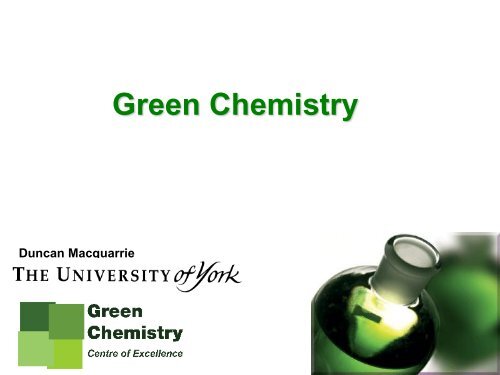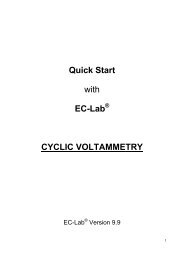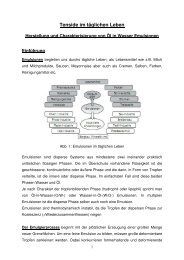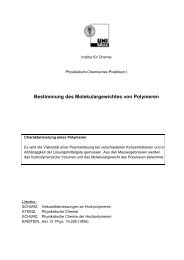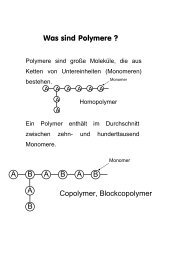What is GREEN CHEMISTRY? - CePoL/MC NAWI Graz
What is GREEN CHEMISTRY? - CePoL/MC NAWI Graz
What is GREEN CHEMISTRY? - CePoL/MC NAWI Graz
Create successful ePaper yourself
Turn your PDF publications into a flip-book with our unique Google optimized e-Paper software.
Duncan Macquarrie<br />
Green Chem<strong>is</strong>try
Benefits of the chemical industry
Chem<strong>is</strong>try – A dirty word!<br />
Pollution<br />
Danger!<br />
Waste D<strong>is</strong>posal<br />
D<strong>is</strong>ease<br />
Toxic<br />
Em<strong>is</strong>sions<br />
Depletion of<br />
natural resources<br />
Accidents<br />
Cancer<br />
Landfill
<strong>What</strong> <strong>is</strong> <strong>GREEN</strong> <strong>CHEMISTRY</strong>?<br />
Green Chem<strong>is</strong>try <strong>is</strong> all about the design of chemical processes<br />
and products that reduce or eliminate the use and generation<br />
of hazardous substances.<br />
12 principles of<br />
Green Chem<strong>is</strong>try<br />
1. Prevention<br />
2. Atom economy<br />
3. Less hazardous chemical syntheses<br />
4. Designing safer chemicals<br />
5. Safer solvents and auxiliaries<br />
6. Design for energy efficiency<br />
7. Use of renewable feedstocks<br />
8. Reduce derivatives<br />
9. Catalys<strong>is</strong><br />
10. Design for degradation<br />
11. Real-time analys<strong>is</strong> for pollution prevention<br />
12. Inherently safer chem<strong>is</strong>try for accident prevention<br />
Anastas, P. T.; Warner, J. C. Green Chem<strong>is</strong>try: Theory and Practice, Oxford University Press: New York, 1998.
<strong>What</strong> <strong>is</strong> <strong>GREEN</strong> <strong>CHEMISTRY</strong>?<br />
A Series of Reductions<br />
Cost<br />
Materials<br />
R<strong>is</strong>k &<br />
Hazard<br />
Reducing<br />
Energy<br />
Waste<br />
Nonrenewables
• Leg<strong>is</strong>lation<br />
New drivers for Green Chem<strong>is</strong>try<br />
– REACH (Reg<strong>is</strong>tration, Evaluation and Author<strong>is</strong>ation of Chemicals)<br />
• all chemicals used in Europe<br />
– ROHS (Restriction on the use of Hazardous Substances)<br />
• heavy metals, chromate, (some) polybrominated compounds<br />
– COMAH (Control of Major Accident Hazards)<br />
• storage of chemicals<br />
– Detergents<br />
– Electronic and Electrical equipment<br />
• The Market<br />
Subject to major<br />
new leg<strong>is</strong>lation<br />
– Increasing price of oil<br />
– Increasing price of key commodity chemicals<br />
– Increasing demand for greener / “natural” products
Pressures on the chemical industry across<br />
the lifecycle<br />
Raw<br />
Materials<br />
Chemical<br />
Manufacturing<br />
Product<br />
use/fate<br />
Increasing<br />
petrochemical<br />
prices<br />
Supply problems<br />
due to dimin<strong>is</strong>hing<br />
resources and market<br />
d<strong>is</strong>tortions<br />
Increased<br />
Costs of<br />
Hazardous<br />
Waste<br />
D<strong>is</strong>posal<br />
Increasing<br />
Energy<br />
Costs<br />
Stricter<br />
Leg<strong>is</strong>lation<br />
Increasing costs<br />
for storing hazardous<br />
substances<br />
Increasing<br />
Public/NGO<br />
concerns<br />
New<br />
leg<strong>is</strong>lation<br />
(e.g. REACH)<br />
Increasing<br />
pressure<br />
from end users<br />
/retailers<br />
Environmental<br />
impact (e.g. degradability)<br />
becoming part of approval<br />
process (e.g. for new drugs)
Current Feedstocks<br />
Praveen V. Vadlani<br />
Grain Science and Industry Department<br />
Kansas State University<br />
Towards a Bio-Based Economy<br />
Molded parts<br />
Oil<br />
Refining<br />
Chem<strong>is</strong>try & Chemical Engineering<br />
Fuels<br />
New Feedstocks<br />
Solvents<br />
Crops<br />
Biomass<br />
Biological Engineering<br />
Fibers<br />
Source: www.dupont.com
Processes / Processing<br />
Sucrose<br />
10
The Fuel Ethanol Process<br />
Break down e.g. starch to d<strong>is</strong>solved sugars<br />
transformation of sugar (glucose) into ethanol<br />
(e.g.: yeast converts glucose into ethanol)<br />
purification of ethanol to a concentrated form<br />
(d<strong>is</strong>tillation)<br />
11
Green Chem<strong>is</strong>try<br />
Bioethanol in Austria
Green Chem<strong>is</strong>try<br />
Bioethanol in Austria


